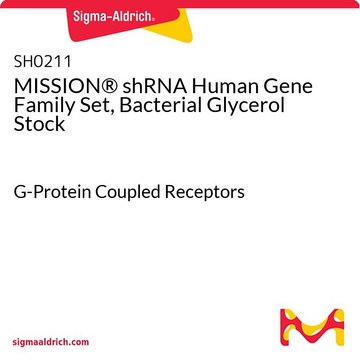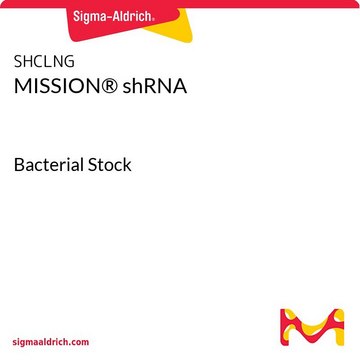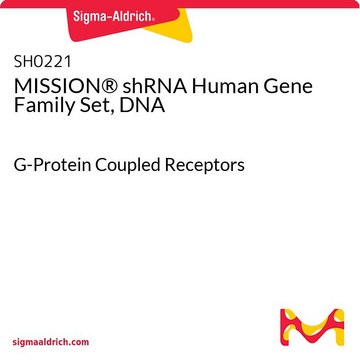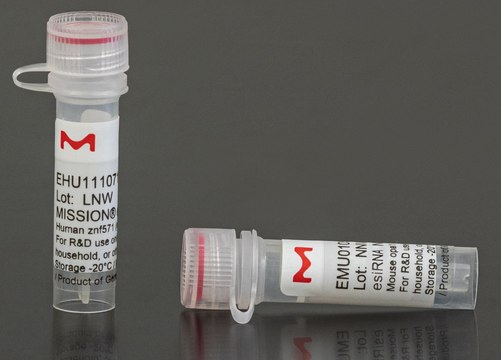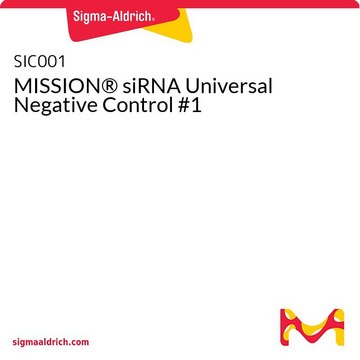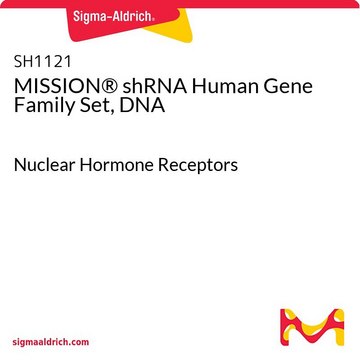SH0231
MISSION® shRNA Human Gene Family Set, Lentiviral Particles
G-Protein Coupled Receptors
Sign Into View Organizational & Contract Pricing
Select a Size
All Photos(1)
Select a Size
Change View
About This Item
UNSPSC Code:
41106609
NACRES:
NA.51
Recommended Products
product line
MISSION®
storage temp.
−70°C
Gene Information
Looking for similar products? Visit Product Comparison Guide
Related Categories
General description
Lentiviral particles (representational, plate titer) are provided in 96-well plates that are barcoded for simple identification. Aliquots of 4 x 50μl are provided to prevent the need for excessive freeze/thaw, and maximize functional viral particles. Each gene family set is representationally titered (10% of clones). Fully titered sets are also available, for more information inquire at RNAi@sial.com. A CD containing RefSeq, gene description, gene symbol, clone ID, hairpin sequence, locus link, and plate map positions are provided with the gene family set.
Other Notes
Each MISSION shRNA clone is constructed within the lentivirus plasmid vector, pLKO.1-Puro, followed by transformation into Escherichia coli. The pLKO.1-Puro vector contains bacterial (ampicillin) and mammalian (puromycin) antibiotic resistance genes for selection of inserts in either bacterial or mammalian cell lines. Each clone set consists of an average of 3-5 constructs that have been designed against each target gene using a proprietary algorithm. Therefore, a range of knockdown efficiency, with at least one construct from each gene set being >70%, can be expected when using these clones. This allows one to examine the effect of loss of gene function over a large series of gene knockdown efficiencies. Each shRNA construct has been cloned and sequence verified to ensure a match to the target gene.
For a detailed listing of other available gene family sets, visit the gene family set website.
Number of Genes: 541, Number of Clones: 2864
The exact gene and clone count at time of purchase may vary slightly as the TRC library is continually updated.
Legal Information
Use of this product is subject to one or more license agreements. For details, please see http://sigmaaldrich.com/missionlicense .
MISSION is a registered trademark of Merck KGaA, Darmstadt, Germany
Storage Class Code
12 - Non Combustible Liquids
WGK
WGK 3
Flash Point(F)
Not applicable
Flash Point(C)
Not applicable
Personal Protective Equipment
dust mask type N95 (US), Eyeshields, Gloves
Regulatory Information
新产品
Choose from one of the most recent versions:
Certificates of Analysis (COA)
Lot/Batch Number
It looks like we've run into a problem, but you can still download Certificates of Analysis from our Documents section.
If you need assistance, please contact Customer Support.
Already Own This Product?
Find documentation for the products that you have recently purchased in the Document Library.
Richard M Eglen
Proceedings of the Western Pharmacology Society, 48, 31-34 (2006-01-19)
G protein coupled receptors (GPCRs) are an important class of ligand-activated proteins that regulate cellular metabolism. It is now appears that GPCR function is highly dependent upon the cellular environment in which it is expressed. Indeed, the cell phenotype influences
Miles D Thompson et al.
Methods in molecular biology (Clifton, N.J.), 448, 109-137 (2008-03-29)
Genetic variation in G protein-coupled receptors (GPCRs) results in the disruption of GPCR function in a wide variety of human genetic diseases. In vitro strategies have been used to elucidate the molecular pathologies that underlie naturally occurring GPCR mutations. Various
G Milligan
Trends in endocrinology and metabolism: TEM, 9(1), 13-19 (2008-04-15)
Research on the structure, regulation and signalling properties of the family of seven-transmembrane-helix, heterotrimeric guanine nucleotide-binding protein (G-protein)-coupled receptors (GPCRs) continues at a frantic pace. This reflects their central role in transmission of hormone- and neurotransmitter-encoded information across the plasma
R Zufferey et al.
Nature biotechnology, 15(9), 871-875 (1997-11-05)
Retroviral vectors derived from lentiviruses such as HIV-1 are promising tools for human gene therapy because they mediate the in vivo delivery and long-term expression of transgenes in nondividing tissues. We describe an HIV vector system in which the virulence
Sheila A Stewart et al.
RNA (New York, N.Y.), 9(4), 493-501 (2003-03-22)
Genome-wide genetic approaches have proven useful for examining pathways of biological significance in model organisms such as Saccharomyces cerevisiae, Drosophila melanogastor, and Caenorhabditis elegans, but similar techniques have proven difficult to apply to mammalian systems. Although manipulation of the murine
Our team of scientists has experience in all areas of research including Life Science, Material Science, Chemical Synthesis, Chromatography, Analytical and many others.
Contact Technical Service